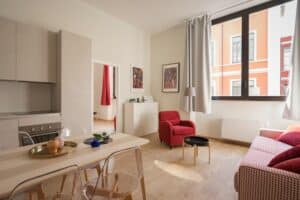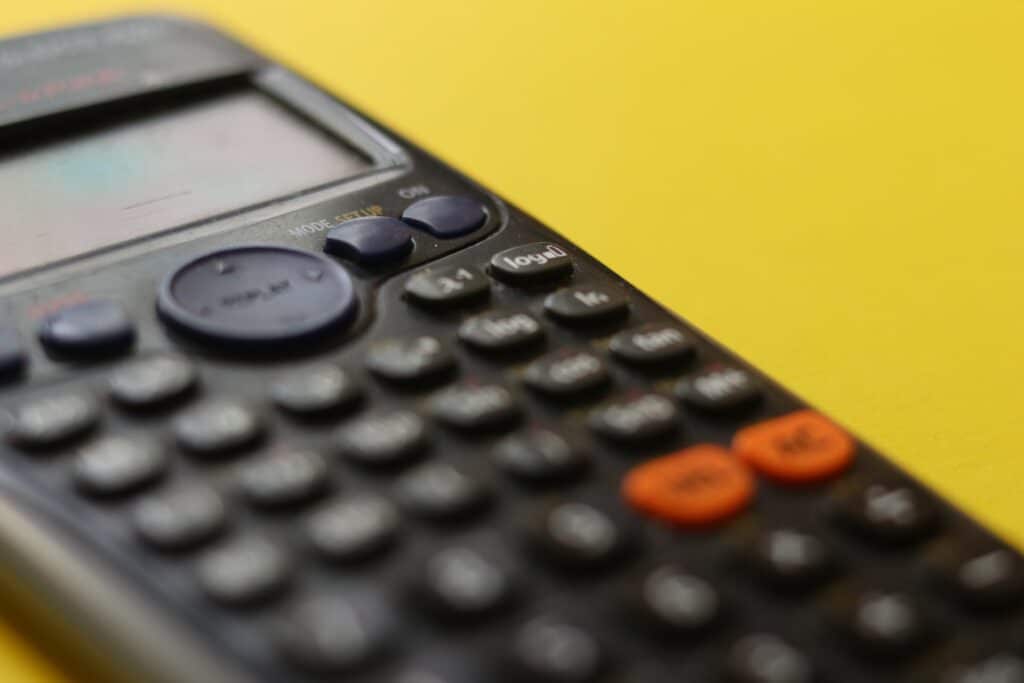Introduction – How Much kWh Does An Apartment Use
[Update 1/21/2024: we updated the electricity costs even though the total kWh remains unchanged]
The average apartment uses 5604 kWh per year. Want to know about the source of data, analysis and the cost of electricity? Read on for our analysis from official statistics. Many people don’t consider their electricity bill when moving into a new apartment even though electricity costs are a significant part of monthly expenditure.

Different apartments will have different rates for their electricity use, depending on the company that provides the service and other local factors. So, how much kWh does an apartment use? Below we show you our calculations and use numbers from 2023 where possible.
Apartment Electricity Usage – Per Day, Month And Year (2024)
We calculated that the average apartment uses 16 kWh per day, 486 kWh per month, or 5832 kWh per year on average. The table below shows usage and cost clearly (source: EIA).
| Frequency | Average Electricity Use per Apartment (kWh) | Electricity Cost per Apartment ($) |
| Daily | 16 kWh | $2.72 |
| Monthly | 467 kWh | $79.39 |
| Yearly | 5604 kWh | $952.68 |
| Instantaneous | 0.7 – 2.0 (kilowatts) | – |
The true figure will depend on the size of the apartment, how many people live there, and how much electricity is used daily. The average cost of electricity per month for an apartment is around $80.
But, again, this will vary depending on the local rates and the amount of electricity used.
If you’re moving into a new apartment, you must ask your landlord or property manager about the monthly electricity rate. This way, you can budget accordingly and avoid surprises on your monthly bill.
Calculating The kWh Usage For An Apartment On Average
We can back-calculate from EIA statistics how much electricity is used by an apartment. We know the numbers for combined apartments and houses as the average household electricity use.
We know also that EIA compiled statistics to show two essential figures. First the percentage of apartments out of all dwellings is 17%, as surveyed in 2009. So the weighted average of house and apartment electricity costs should be the overall average. That is the following relation:
0.83 EH + 0.17 EA= 854 kWh / month
EH is the electricity used by a house. EA is the electricity used by an apartment. We also know that on average apartments use 50% less energy than houses.
Of course, it’s more complicated than that because bigger apartments with more units are more efficient but we’re going to use a single average figure which inherently has sizes and insulation and efficiency rolled into it. This can be written down as the following mathematical expression:
EH = 2 · EA
These two equations, combined, lets us calculate that the average apartment uses 467 kWh / month of energy.
We also know from EIA that electricity costs for 2023 are $0.16 per kWh over all the states which lets us calculate the average apartment electricity usage and cost.
Factors That Will Make This Figures Different
How much a given apartment uses kilowatt-hours (kWh) depends on various factors. Primarily, it depends on the size and age of an apartment as well as the lifestyle habits and energy-efficiency practices of its occupants.
For example, an older building with larger living areas and single-glazed windows will likely consume much more energy than a newer, smaller unit with double-glazing.
An average one and two-bedroom apartment use electricity at a rate of 20-30kWh per day. This figure can vary greatly depending on the apartment’s size and energy efficiency.
For example, a two-bedroom apartment in an older building could use up to 50kWh per day, while a new one-bedroom apartment might only use 15kWh.
In Florida, one-bedroom apartments will use about 25kWh per month over the summer due to heating, and two-bedroom apartments 40kWh.
In NYC, one-bedroom apartments will use about 40kWh per month, and two-bedroom apartments 55kWh.
It’s important to account for electricity costs when renting an apartment. Make sure to inquire with your landlord or property manager to understand the local rates, so you can budget accordingly.
With some intelligent energy-saving practices, such as installing LED lightbulbs and unplugging appliances when not in use, you can keep your electricity bills manageable.
In terms of monthly electricity costs, this translates to around $50-$150 for an average-sized apartment.
Again, this varies significantly depending on local rates, the amount of electricity used each month, and the efficiency practices of its occupants.
If you’re considering moving into a new apartment, it’s important to ask your landlord or property manager about their monthly electricity rate so that you can budget accordingly.
In general, electricity use in an apartment is determined by the number of people living there and their habits.
If your household’s electricity usage is on the high side, consider ways to reduce it, such as switching off lights when not needed and using energy-efficient bulbs.
Taking steps like these can help keep your monthly bills low. Opting for green energy sources can also help lower your electricity costs while reducing your carbon footprint.
Efficiency Influences How Much Electricity An Apartment Uses
Additionally, how efficiently these items are maintained can play a role. If larger electronics such as air conditioners or dryers aren’t properly inspected for maintenance, then they may use more energy than intended.
Temperature controls within the apartment can also cause fluctuations in usage; individuals should be aware of their heating/cooling choices to avoid a spike in bills, as temperature changes heavily impact electricity usage.
Finally, with technology always improving, newer products such as smart thermostats allow users to better monitor their energy consumption, providing them with options to lower their electrical costs.
New building materials, furniture, technology means its possible to make changes to improve the eco-friendliness of bedrooms and other rooms.
How To Estimate Your Monthly Electricity Usage?

Estimating your monthly electricity usage can be a valuable tool to help you plan for future costs and stay in control of your bills. The first step is to review your past bills and take note of the average or highest amount of kilowatt-hours (kWh) used.
You can then use this figure as a starting point to estimate your future electricity costs. It’s important to keep in mind that some variables, such as major appliance changes, seasonal energy needs, weather conditions, and rate increases, can change how much energy you use from month to month.
To get the most accurate estimate possible, consider factors such as: How many people live in the home? How often do you run air conditioning or other large appliances?
Are energy-efficiency measures taken recently? Doing so will help create an estimate reflective of what you’re likely to use each month—giving you a ballpark figure to keep in mind when preparing for your energy payments.
Tips For Reducing Your Electricity Consumption In An Apartment
Saving money on electricity while living in an apartment can be difficult. However, there are some easy tips you can employ to help reduce your electric bill. First and foremost, replacing light bulbs in your apartment with LED bulbs is a great start to reducing your electricity consumption.
LEDs consume 10 – 25% less energy than traditional incandescent bulbs and last as much as 8 times longer. Secondly, try unplugging all appliances, such as TVs, microwaves, computers, and cell phone chargers, when not in use.
When you unplug devices when not in use, the meters that measure electricity usage won’t register them as using power. Even when plugged in, they slowly consume energy.
Lastly, take advantage of any additional insulation available for your apartment, such as floor-length curtains for windows or door sweepers for the door frame.
The more airtight your walls are, the less chance of hot air from outside creeping in during summer months forcing the AC to run more often – and at lower thermostat settings too!
Adjust the thermostat and troubleshoot issues when the thermostat isn’t able to reach the set temperature. With just a few small changes, you can easily reduce your electricity consumption while living in an apartment and start saving money immediately!
Conclusions
In conclusion, many factors determine the amount of electricity used in an apartment, including size, appliances, maintenance, and temperature controls.
Estimating your monthly electricity usage helps you budget future costs and stay on top of bills.
And with simple tips such as switching to LED lightbulbs, unplugging electronics when not in use, and taking advantage of insulation options – you can easily reduce your electricity consumption while living in an apartment.
So if you’re looking to save some extra cash by reducing your electricity bill – all it takes is a little knowledge and effort. Good luck!
